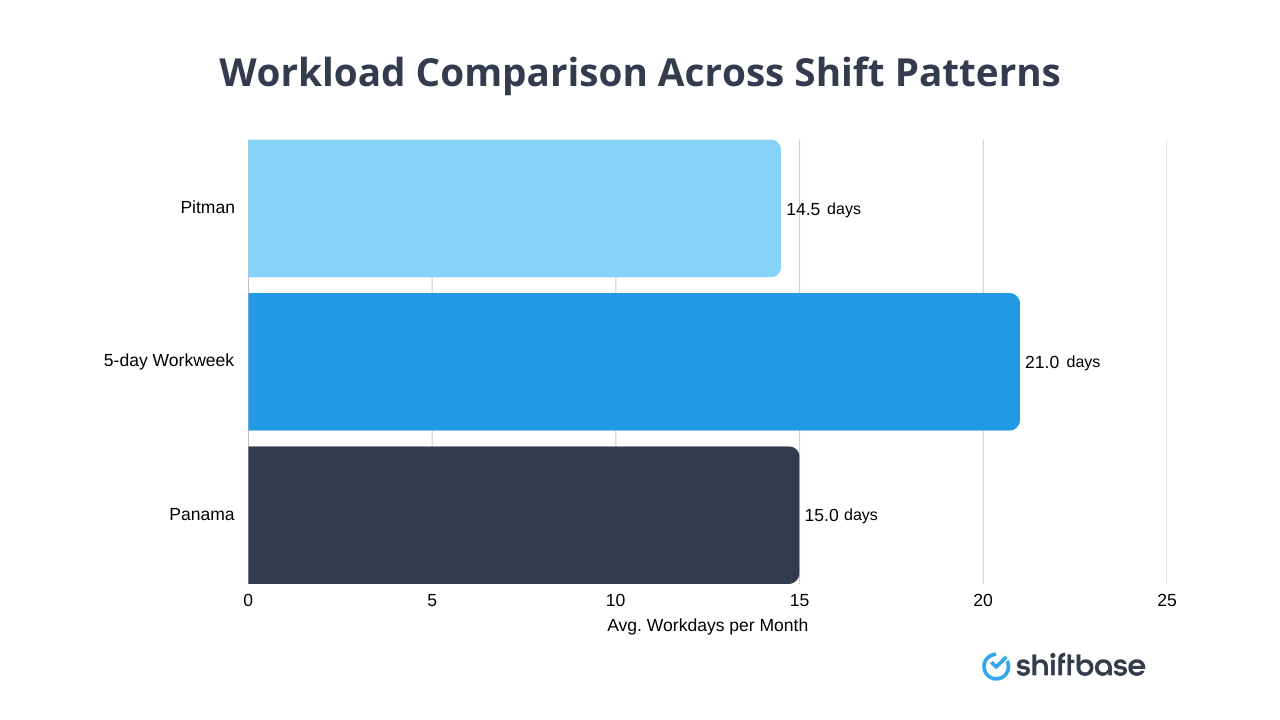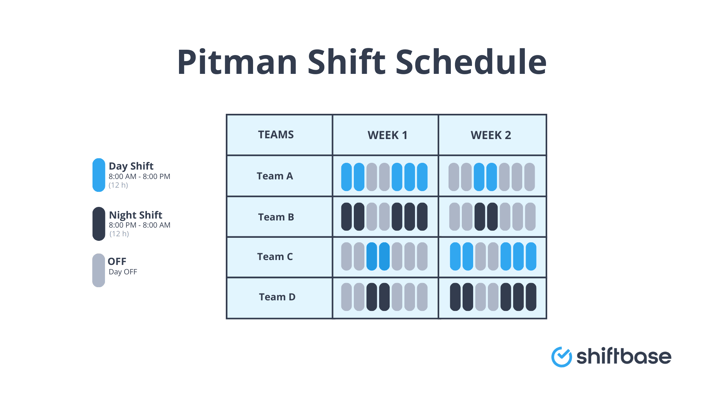In this article, we'll unravel the details of the Pitman Shift Schedule, offering insights into its structure and benefits.
What is a Pitman shift schedule?
Let’s say you need your business covered 24/7 — think hospitals, security teams, or even a bakery that never sleeps. The Pitman shift schedule is one of those clever setups that helps you do just that… without totally exhausting your team.
This rota runs on a 2-2-3 pattern:
Sounds odd at first, but here’s the magic:
It repeats every 2 weeks, and over that time, employees work only 7 out of 14 days — not bad for full-time, right?
Quick overview:
| Week |
Mon |
Tue |
Wed |
Thu |
Fri |
Sat |
Sun |
| 1 |
🟩 Work |
🟩 Work |
❌ Off |
❌ Off |
🟩 Work |
🟩 Work |
🟩 Work |
| 2 |
❌ Off |
❌ Off |
🟩 Work |
🟩 Work |
❌ Off |
❌ Off |
🟩 Work |
🟩 = Work day | ❌ = Day off
This pattern is especially handy for 12-hour shifts — it means employees get long breaks, more predictable rest days, and even every other weekend off. For some teams, that’s a game-changer for morale and work-life balance.
Pros and cons of the Pitman shift schedule
Like any shift pattern, the Pitman rota comes with a few perks… and a few headaches. Let’s look at both sides.
✅ Pros: why some teams love it
-
Fewer workdays
Employees only work 7 out of every 14 days. That’s a lot of days off while still covering full-time hours.
-
Long weekends, every other week
Every other weekend is a full 3-day break — great for recovery and work-life balance.
-
Predictable routine
The repeating 2-week cycle is easy to follow and great for long-term planning.
-
Good coverage for 24/7 operations
Works brilliantly for businesses that never shut down — like emergency services, healthcare, and manufacturing.
-
Stronger team bonding
Since teams often rotate together, people get to know each other better — fewer awkward “who are you again?” moments on shift.
❌ Cons: things to watch out for
-
Long shifts = long days
Typically used with 12-hour shifts, which can be exhausting, especially for physically or mentally demanding roles.
-
Increased fatigue
Back-to-back long shifts can wear people down if rest, nutrition, and recovery aren’t managed properly.
-
Not great for part-timers or flexibility
The schedule is rigid, which makes it tricky to mix with part-time or freelance staff.
-
Harder to swap shifts
Because of the pattern, swapping days off or making last-minute changes can be a bit of a puzzle.

Compliance and legal considerations
Before you roll out a Pitman rota, it’s important to double-check that it’s legal, safe, and fair. Below we’ll cover the key rules for both UK and US employers.
🇬🇧 In the UK: what employers need to know
The Pitman shift schedule can be fully compliant in the UK — if you follow the Working Time Regulations. Here’s what to keep an eye on:
🕒 Working Time Regulations 1998
-
Max average weekly hours: 48 hours per week (unless staff opt out).
-
Daily rest: 11 consecutive hours off in every 24-hour period.
-
Weekly rest: 24 hours off per 7-day period (or 48 hours every 14 days).
-
Breaks: Workers must get a 20-minute break if working over 6 hours.
💡 Tip: With 12-hour shifts, it’s vital to ensure breaks are clearly scheduled and taken — ideally more than one.
🌙 Night work rules
If the Pitman schedule includes overnight shifts:
-
Max night shift average: 8 hours in any 24-hour period, averaged over 17 weeks.
-
Health assessments: Night workers must be offered a free health check before starting and at regular intervals.
💰 National Living Wage (2025)
As of April 2025:
-
The National Living Wage is £11.44/hour for workers aged 21+.
-
If using long shifts, be mindful that unpaid breaks don’t count toward this.
📋 Keep records
Make sure you:
🇺🇸 In the US: key legal points (state laws vary!)
The US doesn’t have a one-size-fits-all labour law like the UK. Compliance depends heavily on the state you operate in — but here’s what you should consider across the board:
⏱ Overtime laws (Fair Labor Standards Act – FLSA)
-
Any hours worked over 40 hours/week must be paid at 1.5x the regular pay rate.
-
Yes, even if you compress those hours into fewer days (like 12-hour shifts).
-
Some states, like California, also apply daily overtime (after 8 hours/day).
💼 Worker classification
👶 Paid family and medical leave (PFML)
-
States like New York, New Jersey, California, and Oregon now offer or mandate PFML schemes.
-
Employers must accommodate leave requests, even if the team’s on a tight schedule like Pitman.
💸 Breaks and meals
-
Federal law doesn’t require breaks, but many states do (e.g. 30-min unpaid lunch after 5 hours).
-
Make sure breaks are built into those 12-hour shifts — and documented.
Tips for implementing the Pitman schedule
Rolling out a new shift pattern like Pitman can feel a bit like trying to solve a Rubik’s cube blindfolded — but don't worry, if you follow a few clear steps, you’ll make it a smooth switch for everyone.
1. Decide if Pitman is the right fit
Before you change anything, check if this schedule actually suits your business needs. Ask yourself:
-
Do we need 24/7 coverage?
-
Can our team handle 12-hour shifts?
-
Will staff appreciate longer breaks and alternate weekends off?
💡 Tip: Survey your employees first. They’ll spot issues you might not have thought of!
2. Plan your teams carefully
The Pitman pattern usually needs at least two teams (but often four to avoid burnout):
🧮 Do the maths:
Make sure you have enough people to cover shifts while allowing for holidays, sick days, and emergencies.
3. Create and share a draft schedule
Mock up the rota for 2–3 months ahead and check:
-
Are the work/rest periods balanced?
-
Are legal rest and break times respected?
-
Does it fairly rotate weekends off?
4. Communicate clearly (and early)
Nobody likes shift changes sprung on them last minute.
-
Explain why you’re moving to Pitman.
-
Show the benefits (hello, regular long weekends ✈️).
-
Be honest about the challenges (long shifts are tough).
🎤 Hold Q&A sessions
Invite questions and feedback. It'll build trust and help you spot problems early.
5. Trial it — don’t rush full rollout
Test the schedule with a smaller team first if you can:
-
Monitor workload, fatigue, absence rates.
-
Check if staffing levels are truly enough.
-
Tweak the pattern if you spot bottlenecks.
A 3-month pilot gives you real data without committing long-term.
6. Monitor and adjust regularly
Even after launch, keep reviewing:
-
Are there spikes in overtime or absenteeism?
-
Are employees coping well with the 12-hour days?
-
Do you need to hire more staff to keep it sustainable?
💡 Remember: no rota is “set and forget.” It needs tweaking as your business (and team) changes.
How Shiftbase makes managing a Pitman shift schedule easier
Setting up a Pitman rota sounds great — until you’re buried under spreadsheets, last-minute swaps, and complaints about missing rest days. That’s where Shiftbase steps in.
With employee scheduling tools built for 24/7 operations, Shiftbase helps you design clear Pitman schedules in minutes, not hours. You can easily:
-
Build rotating 2-2-3 shift patterns,
-
Visualise team coverage at a glance,
-
Spot gaps before they turn into staffing emergencies.
And it’s not just about planning. Time tracking ensures you stay compliant with working time laws, while absence management helps you juggle holidays, sick leave, and last-minute callouts without losing your mind.
💬 In short: you get full control over a complex rota, with way less hassle.
🎯 Want to see how much easier it can be?
Try Shiftbase for free for 14 days — no credit card needed, just smarter scheduling from day one.

Your work schedule in one central place!


